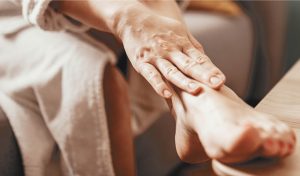By Dr. Lori DeBlasi
 Why does Diabetes effect the feet???
Why does Diabetes effect the feet???
Factors that contribute to foot issues in a patient with Diabetes include:
1. Neuropathy
In the US, the most common cause of peripheral neuropathy is Diabetes. According to the American Diabetes Association, 60 to 70% of patients with diabetes will develop neuropathy within their lifetime. The most common symptoms of peripheral neuropathy include burning, numbness, tingling, or shooting or stabbing pain in the toes.
2. Circulation/Blood flow
An elevated blood sugar level stiffens the arteries and causes narrowing of the blood vessels. This results in decreased blood flow and oxygen to the feet. An elevated blood sugar level also decreases the function of red blood cells that carry nutrients to the tissue. This lowers the efficiency of the white blood cells that fight infection. Without sufficient nutrients and oxygen, a wound heals slowly.
3. Immune System
Diabetes lowers the efficiency of the immune system, the body’s defense system against infection. A high glucose level causes the immune cells to function ineffectively, which raises the risk of infection for the patient.
Diabetic Do’s
Check your feet every day for: Cuts, blisters, redness, swelling, bruises, changes to the toenails, such as thickening or discoloration.
Check your blood sugar routinely and make it a goal to get the HgbA1C <7%.
Eat right – Adequate protein, carbohydrates and vitamin C intake are key factors to aid healing. Consider seeing a registered dietician.
Exercise – Walking can keep weight down and improve circulation. Be sure to wear appropriate athletic shoes when exercising.
Moisturize your feet – but NOT between the toes.
Get periodic foot exams – Regular checkups by a podiatrist, at least annually, are the best way to ensure that your feet remain healthy.
Diabetic Don’ts
Don’t ignore any abnormality in appearance or pain.
Don’t perform “bathroom surgery”. Seek medical treatment.
Don’t use medicated corn/callus pads – Over-the-counter products can burn the skin and cause damage to the foot for people with diabetes.
Don’t walk around barefoot or only in socks (even in your own home). Wear thick, soft white socks. Avoid socks with seams, which could rub and cause blisters or other skin injuries. The risk of cuts and infection is too great for those with diabetes.
Don’t wear tight shoes. Foot size and shape may change over time. Shoes that fit properly are important to those with diabetes. Have new shoes properly fitted and measured.
Don’t soak your feet in hot water, walk on hot sand or pavement and don’t rest your feet against a fire or space heater.
Don’t smoke! Diabetics who smoke are more likely than nonsmokers to have trouble with insulin dosing and with controlling their disease. Smokers with diabetes have higher risks for serious complications, including Heart and kidney disease, Poor blood flow in the legs and feet that can lead to infections, ulcers, and possible amputation, Retinopathy (an eye disease that can cause blindness) and Peripheral neuropathy.
These guidelines are initiative-taking and preventive measures to try to reduce the risk of foot issues in Diabetic patients. It is recommended every person with Diabetes have a yearly foot exam by a Podiatrist. Preventative care is a key component – make your appointment TODAY!
Disclaimer: This content is not intended to be a substitute for professional medical advice, diagnosis, or treatment. Always seek the advice of your physician or other qualified health care provider with any questions you may have regarding a medical condition.
Dr. Lori DeBlasi is certified by the American Board of Foot and Ankle Surgery.
Dr. DeBlasi works at the Estero office of Family Foot & Leg Center. She is accepting new patients. To make an appointment call 239-430-3668 or visit www.NaplePodiatrist.com.
21401 Corkscrew Village Lane,
Suite 4
Estero, FL 33928
(239) 430 – 3668 (FOOT)
www.NaplesPodiatrist.com







